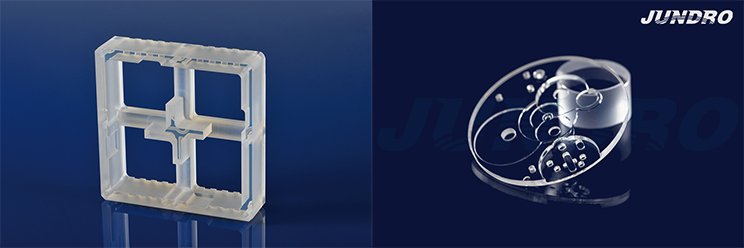Bei beiden Materialien handelt es sich um hochstabile Glaskeramiken mit geringer Wärmeausdehnung. Aufgrund ihrer ausgezeichneten mechanischen Eigenschaften werden sie häufig in der High-Tech-Industrie eingesetzt, z. B. für Linsen astronomischer Teleskope, Strukturbauteile für die Weltraumforschung, hochpräzise Instrumente usw., also für Geräte, die empfindlich auf Temperaturschwankungen reagieren.
Grundlegende Konzepte von dehnungsarmem Glas
Was ist Glas mit geringer Ausdehnung?
Geringe Wärmeausdehnung bedeutet, dass sich das Material bei Temperaturschwankungen kaum verändert. Diese Eigenschaft macht es widerstandsfähig gegen Wärmeschocks, die in der Praxis die Hauptursache für Risse im Material sind. Im Folgenden sind einige gängige Glasmaterialien mit geringer Wärmeausdehnung aufgeführt:
- Borosilikatglas
- Zerodur
- Clearceram
- ULE
- Aluminosilikatglas
Vergleich der wichtigsten Merkmale
Clearceram gegen Zerodur
Farbkontrast
Gelber Schimmer von Zerodur vs. klares Erscheinungsbild von Clearceram
Im Vergleich zu Zerodur hat Clearceram ein klares Erscheinungsbild mit hoher Transparenz und eignet sich besser für optisch klare Anwendungen.

Beispiel einer Fallstudie
Prüfung von Teleskopspiegeln
- Quelle: Studie veröffentlicht am PubMed (Tests zur Dimensionsstabilität)
- Methodik: Die aus Zerodur und Clearceram-Z hergestellten Spiegel wurden zur Messung der Stabilität thermischen Zyklen (-40°C bis +90°C) unterzogen.
- Ergebnisse:
- Clearceram-Z: Die Verformung blieb innerhalb von ±0,1 μm/m°C.
- Zerodur: Die Abweichungen erreichten ±0,2 μm/m°C.
- Schlussfolgerung: Clearceram-Z erwies sich als überlegen für hochpräzise optische Systeme, die extreme thermische Stabilität erfordern.
Test der chemischen Beständigkeit
- Quelle: OHARA- und Schott-Vergleichsstudien zu Säureimmersionstests.
- Feststellungen:
- Beide Materialien widerstanden der Oberflächenerosion nach 24 Stunden in einer 10%-Salzsäurelösung.
- Die Schwankungen der Oberflächenrauhigkeit waren vernachlässigbar (<0,01 μm).
Mechanische Langlebigkeit in der Luft- und Raumfahrt
- Referenz: Technische Analyse von Schott AG.
- Das Ergebnis: Die höhere Biegefestigkeit von Zerodur war bei Luft- und Raumfahrtspiegeln, die hohen mechanischen Belastungen ausgesetzt sind, von Vorteil.
Typische Anwendungsszenarien für Clearceram und Zerodur
Beratung bei Beschaffung und Bearbeitung
Die Wahl des richtigen Herstellers ist besonders wichtig. Wir verfügen über umfassende Erfahrung in der Zerodur-Verarbeitung und sind bestrebt, hochwertige Präzisionskeramikkomponenten zu liefern, die die Erwartungen unserer Kunden erfüllen oder sogar übertreffen. Wenn Sie technische Anforderungen haben, wenden Sie sich bitte an unsere Experten. Wir stehen Ihnen gerne zur Verfügung.
Häufig gestellte Fragen
Welches Material, Clearceram-Z oder Zerodur, eignet sich besser für Luft- und Raumfahrtanwendungen?
- Zerodur eignet sich im Allgemeinen besser für Luft- und Raumfahrtanwendungen, da es sich in weltraumgestützten Systemen wie dem Hubble-Weltraumteleskop bewährt hat. Seine überragende mechanische Festigkeit und Dimensionsstabilität unter extremen Bedingungen machen es ideal für stark beanspruchte Umgebungen, wie etwa beim Start oder in der Umlaufbahn.
- Clearceram-Zist zwar hervorragend für optische Präzisionssysteme geeignet, wird aber eher für Anwendungen verwendet, bei denen eine extrem geringe Wärmeausdehnung und optische Klarheit wichtiger sind als mechanische Robustheit.
Warum ist Zerodur teurer als Clearceram-Z?
- Materialzusammensetzung und Herstellung: Die Herstellung von Zerodur erfordert komplexe Prozesse, um seine außergewöhnlichen mechanischen und thermischen Eigenschaften zu erreichen, insbesondere für großformatige Optiken.
- Bewährte weltraumtaugliche Leistung: Die Zertifizierung und der weit verbreitete Einsatz in der Raumfahrt treiben die Kosten oft in die Höhe.
- Marktnachfrage: Zerodur wird häufig bei einzigartigen und groß angelegten Projekten wie Teleskopspiegeln verwendet, bei denen die Nachfrage nach großen Mengen oder großen Teilen die Kosten in die Höhe treibt.
- Clearceram-Z wird dagegen häufig bei kleineren oder mechanisch weniger anspruchsvollen Anwendungen eingesetzt, was die Gesamtkosten senken kann.
Gibt es alternative glaskeramische Materialien, die Clearceram-Z oder Zerodur ersetzen können?
- ULE® (Ultra-Low Expansion Glass): Das von Corning hergestellte ULE ist ein Hochleistungsmaterial mit extrem geringer Wärmeausdehnung, das häufig in Teleskopspiegeln und Halbleitergeräten verwendet wird.
- Astrositall: Eine kostengünstige Alternative für Anwendungen im Bereich der Dimensionsstabilität, die häufig in der Präzisionsoptik und bei Spiegeln eingesetzt wird.
- Kordierit: Cordierit ist zwar kein direkter Ersatz, bietet aber eine ausgezeichnete thermische und dimensionale Stabilität, insbesondere für strukturelle oder industrielle Anwendungen, die niedrigere Kosten erfordern.
- BOROFLOAT® und SUPREMAX®: Diese Borosilikatgläser können in Anwendungen eingesetzt werden, bei denen Kosten und chemische Beständigkeit wichtiger sind als die thermische Stabilität.
